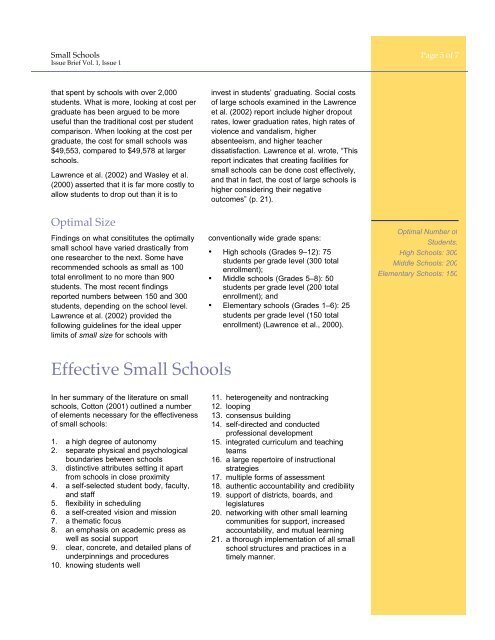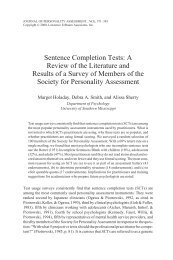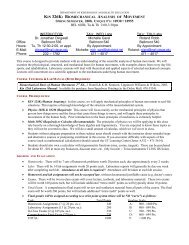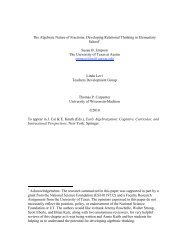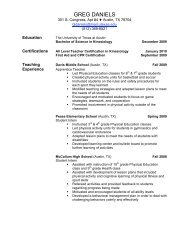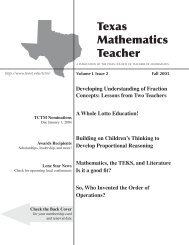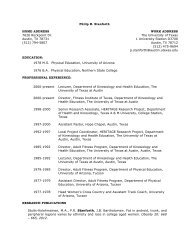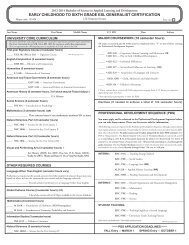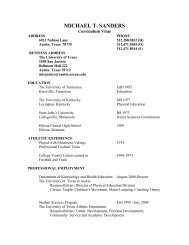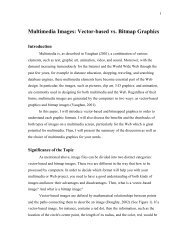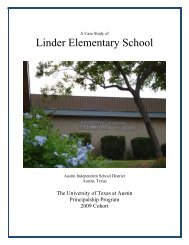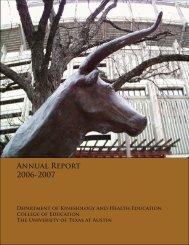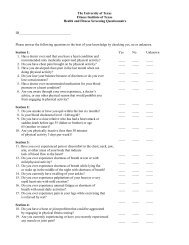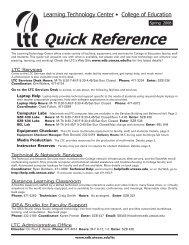High Schools: Size Does Matter - The College of Education - The ...
High Schools: Size Does Matter - The College of Education - The ...
High Schools: Size Does Matter - The College of Education - The ...
Create successful ePaper yourself
Turn your PDF publications into a flip-book with our unique Google optimized e-Paper software.
Small <strong>Schools</strong> Page 5 <strong>of</strong> 7<br />
Issue Brief Vol. 1, Issue 1<br />
that spent by schools with over 2,000<br />
students. What is more, looking at cost per<br />
graduate has been argued to be more<br />
useful than the traditional cost per student<br />
comparison. When looking at the cost per<br />
graduate, the cost for small schools was<br />
$49,553, compared to $49,578 at larger<br />
schools.<br />
Lawrence et al. (2002) and Wasley et al.<br />
(2000) asserted that it is far more costly to<br />
allow students to drop out than it is to<br />
Optimal <strong>Size</strong><br />
Findings on what consititutes the optimally<br />
small school have varied drastically from<br />
one researcher to the next. Some have<br />
recommended schools as small as 100<br />
total enrollment to no more than 900<br />
students. <strong>The</strong> most recent findings<br />
reported numbers between 150 and 300<br />
students, depending on the school level.<br />
Lawrence et al. (2002) provided the<br />
following guidelines for the ideal upper<br />
limits <strong>of</strong> small size for schools with<br />
Effective Small <strong>Schools</strong><br />
In her summary <strong>of</strong> the literature on small<br />
schools, Cotton (2001) outlined a number<br />
<strong>of</strong> elements necessary for the effectiveness<br />
<strong>of</strong> small schools:<br />
1. a high degree <strong>of</strong> autonomy<br />
2. separate physical and psychological<br />
boundaries between schools<br />
3. distinctive attributes setting it apart<br />
from schools in close proximity<br />
4. a self-selected student body, faculty,<br />
and staff<br />
5. flexibility in scheduling<br />
6. a self-created vision and mission<br />
7. a thematic focus<br />
8. an emphasis on academic press as<br />
well as social support<br />
9. clear, concrete, and detailed plans <strong>of</strong><br />
underpinnings and procedures<br />
10. knowing students well<br />
invest in students’ graduating. Social costs<br />
<strong>of</strong> large schools examined in the Lawrence<br />
et al. (2002) report include higher dropout<br />
rates, lower graduation rates, high rates <strong>of</strong><br />
violence and vandalism, higher<br />
absenteeism, and higher teacher<br />
dissatisfaction. Lawrence et al. wrote, “This<br />
report indicates that creating facilities for<br />
small schools can be done cost effectively,<br />
and that in fact, the cost <strong>of</strong> large schools is<br />
higher considering their negative<br />
outcomes” (p. 21).<br />
conventionally wide grade spans:<br />
• <strong>High</strong> schools (Grades 9–12): 75<br />
students per grade level (300 total<br />
enrollment);<br />
• Middle schools (Grades 5–8): 50<br />
students per grade level (200 total<br />
enrollment); and<br />
• Elementary schools (Grades 1–6): 25<br />
students per grade level (150 total<br />
enrollment) (Lawrence et al., 2000).<br />
11. heterogeneity and nontracking<br />
12. looping<br />
13. consensus building<br />
14. self-directed and conducted<br />
pr<strong>of</strong>essional development<br />
15. integrated curriculum and teaching<br />
teams<br />
16. a large repertoire <strong>of</strong> instructional<br />
strategies<br />
17. multiple forms <strong>of</strong> assessment<br />
18. authentic accountability and credibility<br />
19. support <strong>of</strong> districts, boards, and<br />
legislatures<br />
20. networking with other small learning<br />
communities for support, increased<br />
accountability, and mutual learning<br />
21. a thorough implementation <strong>of</strong> all small<br />
school structures and practices in a<br />
timely manner.<br />
Optimal Number <strong>of</strong><br />
Students:<br />
<strong>High</strong> <strong>Schools</strong>: 300<br />
Middle <strong>Schools</strong>: 200<br />
Elementary <strong>Schools</strong>: 150


